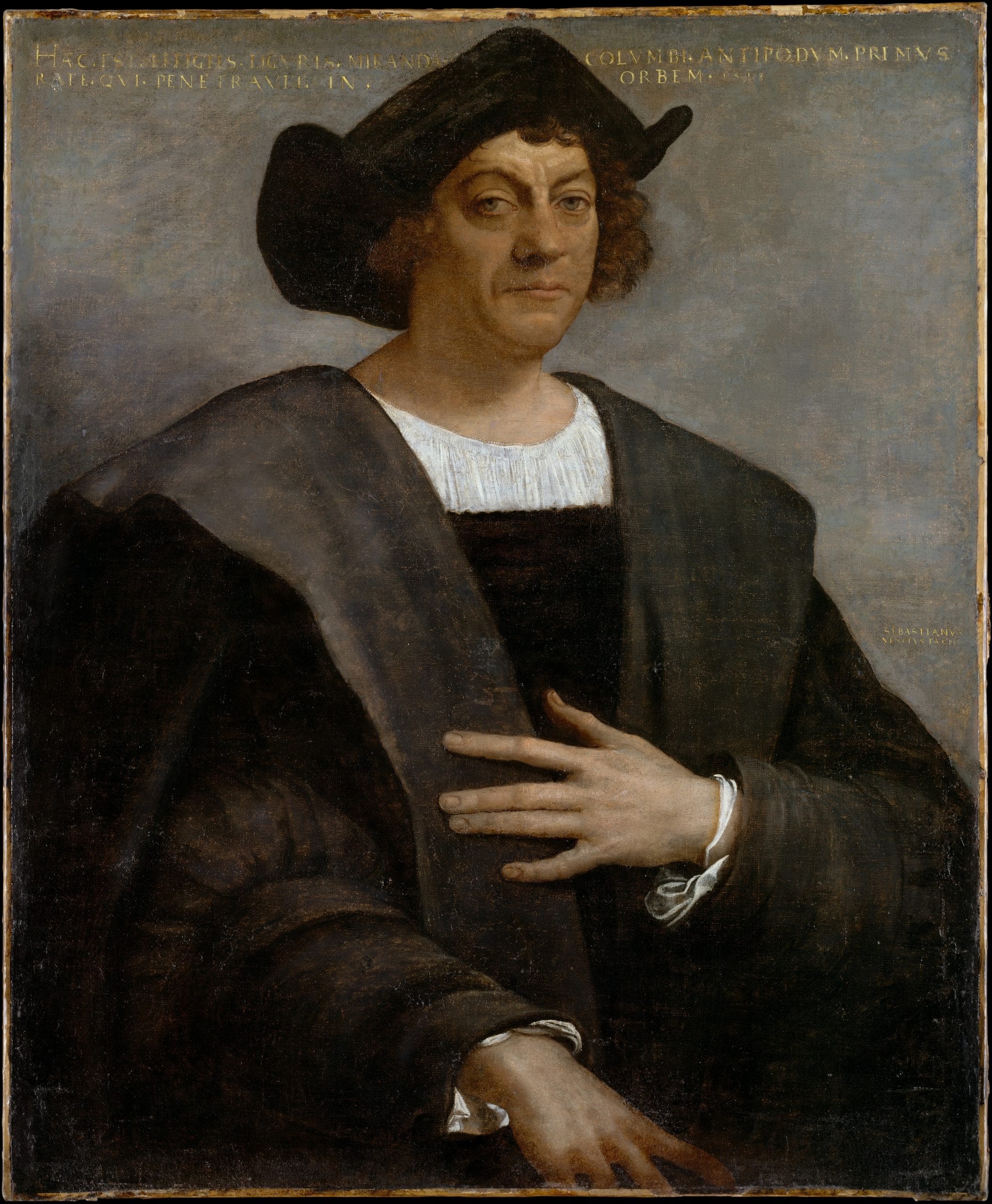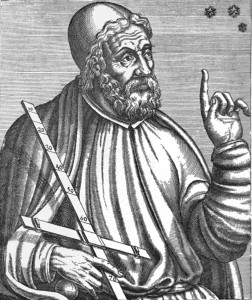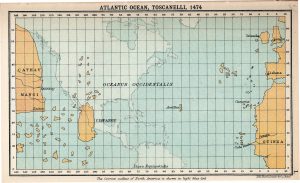Christopher Columbus, the Admiral of the Ocean, went where no one before he had gone. He was ten years seeking support for his venture, governmental and financial. He was criticized for a wild plan to traverse an ocean, which advisors to two kings and a queen said was too far, too speculative, and too likely to lead to unsafe and unrewarded ends. When he returned in year from his first voyage, having discovered a new world across the unmapped Atlantic, his contemporaries marginalized his effort as easily done, on the verge of completion by others, and accomplished with the aid of a secret guide, armed with maps of known locations.
To pacify his sponsors, and in order to seek their support for three more crossings of the Atlantic, Columbus repudiated his finding of a new continent, in order to portray his discoveries as successful steps in finding the western sea route to India. To mollify critics of his egotistic and persuasive personality, Columbus demurred to a god, whose divine guidance lit his path. After his death, the royals of Spain would use the apologetic ramblings of Columbus in a lengthy court action in which they sought to defeat claims of Columbus heirs, by attributing his discovery to others.
There are three undisputable facts regarding Columbus: 1. He and all who sailed with him knew the world was round: 2. Queen Isabella did not pawn her jewels to fund the voyage as her jewels had already been pawned to finance the war to expel the Muslims from Spain: and 3. The quest of Columbus to discover new lands began in Madeira.
The Education of Christopher Columbus
Columbus was a young man with an uncertain future when he landed in Lisbon in 1477. In Lisbon, Columbus worked for his brother Bartholomew, making maps. To meet young ladies after work, Columbus went to church. There he met Dona Filipa Moniz. She was of a noble family in Madeira, clearly above the reach of a common tradesman. She was receptive to talking with the tall, red-haired, blue-eyed, strong, young man, who stood out among the shorter, swarthy Portuguese. Columbus was charming. He had recently come from business dealings in Madeira. They had a common bond. Very soon thereafter, they were married.
The family pedigree of Felipa went back to the 1419 conquest of Madeira by Prince Henry the Navigator of Portugal. Gil Moniz, Felipa’s grandfather, was a trusted companion to the prince. The prince made Moniz governor for life of Porto Santo, Madeira in 1433. The title was bestowed with the right of inheritance, which made the recipient a noble.
The position of governor transferred to the son-in-law of Moniz, Felipa’s father, Bartholomew Perestrelo. Perestrelo was an avid mariner, who amassed an impressive library of books and maps. By the time Columbus met Felipa, her father had been dead for almost twenty years.
The young couple returned to the Perestrelo/Moniz home in Madeira. They were married in 1478. Their son, Diego was born in 1479, the year Felipa died of illness.
Columbus remained in Madeira where his mother-in-law poured into him everything she knew of her late-husband’s travels and exploration aspirations. She left Columbus to absorb the contents of the Perestrelo library, with its extensive collection of maps. To his first-hand knowledge of the seas, Columbus added the knowledge of the time. He read everything in the library and sought out more information. He would emerge from Madeira as a self-educated man, ready to explore beyond the known world.
The Columbus Book Club Reading List
Contrary to 19th century mythology, Columbus and his contemporaries knew the world was round. Over the horizon the Atlantic was boundless. In the selective wisdom of the self-educated man, Columbus combined his new knowledge with the biblical notions of his medieval early life, as he sought to calculate the distance of the breadth of the ocean. He leaned toward accepting those calculations of a shorter distance from Lisbon to India, a distance that would be palatable to sponsors and sailors.
Modern scholars, who portray his assumptions as descriptive of a world more elliptical in shape than a football, have derided Columbus’ calculations, for the distance land-to-land across the Atlantic. Allowing for the fact that the north and south regions of the globe were not mapped in the 15th century, the proportions anticipated by Columbus are reasonable for a round or egg shaped globe, although resulting in a smaller earth.
In the 1440s Gutenberg created a typeset printing machine that made possible duplication of ancient texts. The wisdom of the world, previously held in a very few libraries inhabited by dutiful monks, was made widely available. During the time that Columbus was in Madeira, his world was populated by texts bought as first printed editions by his deceased father-in-law. The written record of intellectual humanity was available to Columbus. A look at his reading material gives insight to ideas formulated by Columbus as he immersed himself in the Perestrelo library.
Columbus read, coveted, and made notes in the margins of texts, some of which he took with him on his voyages. The eclectic array of reading material described the world as it was known and as it was thought to be from the received stories of travelers and the computations of astronomers and philosophers. Maps included islands of fictional places, regarded by 15th century travelers as real.
A basic text for all explorers was Geography, by the 2nd century philosopher, Ptolemy, who lived in the center of intellectual thought of the time, Alexandria. Ptolemy wrote that the world was a sphere, the continuous land mass was adjoined by an ocean, and there was a great southern continent below the known world. Fifteen hundred years later, explorers would still be seeking the southern continent.
It was Ptolemy who established the size of the Atlantic as occupying half the circumference of the earth. Based on what was known of the landmass at the time, the calculation accounts for the smaller earth assumptions of Columbus. Ptolemy was also a cartographer. His maps were set on a grid of longitude and latitude.
It was the 1st century Roman mariner, Pliny the elder, who inspired travel to the islands of the Antipodes in the Atlantic, in his opus work, Natural History. Pliny also argued that there were continents north and south of the known world. His book was a handy guide for mariners who needed cures for gallstones or eye complaints.
The 2nd century Greek, Plutarch, wrote of visions and voices in the air in Lives. In lonely days at sea, Columbus reached for this book as he retreated into his visions and voices. The more Columbus told people of the ethereal voices that guided him on voyages the harder it was to find sailors for his ships.
Strabo lived in what is now Turkey during the time of Christ. He traveled the landscape of Greek and Roman battles. The travels were recorded in his book, Geography. The writings of Strabo were attractive to Columbus as they espoused the notion of more land, less ocean. The smaller the ocean appeared, the more feasible the voyage to India from Spain.
Two new releases for Perestrelo were Imago Mundi, by the French Cardinal, Pierre ď Ally, written around 1400, and Historia Rerum Whique Gestarum, by the mid-15th century pope Pius II. The cardinal offered calculations of a small earth, with a narrow Atlantic Ocean. He established the length of a degree and the length of a solar day at the solstice for use by mariners to calculate their progress at sea, which were employed by Columbus. The pope wrote of the riches of the Orient that lay just a short distance across the Atlantic. As proof of the short sea route to India, the pope relayed the story of Indian merchants who washed up on the shores of Germany in the 12th century.
The hot selling books released in the time of Columbus were The Book of the Marvels of the World, more commonly known as The Book of Marco Polo, written in 1300, and printed in an edition in 1485, and The Travels of Sir John Mandeville, written about the same time as the Marco Polo book, and widely reprinted, not knowing that the knight was as fictional as his travels. Both books inspired Columbus and his contemporaries to travel to far away places to enjoy the natural marvels, with hopes of returning with gems.
Columbus was not a skilled writer, yet he made his own contributions to libraries. Columbus wrote to Paolo Toscanelli, who had stated that China was 5,000 miles west from Lisbon by sea. Toscanelli died in 1482, but not before he sent Columbus maps and charts, which were dutifully preserved.
Columbus kept a log of his travels in which he tried to calculate his progress. Even though those logs may have been “falsified” by Columbus to understate the distance in order not to alarm his crew, they give credible evidence of his travels. In 1500, when Columbus was sent from Haiti to Spain in chains, he compiled a Book of Privileges with all the documents to support the obligation of his sponsors to his family.
Admiral of the Ocean
Columbus spent ten years following the court of Spain from city to city in an effort to obtain their patronage for his voyage to the New World. He visited the court in Portugal and England to diversify his options. When Columbus received his final rebuke from the monarchs of Spain, Columbus was riding away from Cordova on a donkey, headed to the monastery of La Rábida to collect his young son, Diego.
In a stunning climactic moment, Columbus was overtaken by a messenger from the Spanish royal court and invited to return. Historians disagree as to whether the king overruled the queen’s advisors, who dismissed Columbus, by urging that the crown hedge their bets, or the queen pushed the matter because she had a personal affinity for the man who joined her in battle in 1489, during the retaking of Jaén and Baeza. Regardless, with scant resources available, King Ferdinand and Queen Isabella etched themselves into every book of American and Caribbean history with their decision to back the voyage of Columbus in 1492.
Columbus packed up his books and in 1492 prepared for the first of what would become four voyages to the New World. Although the route to the east by sailing west would continue to elude explorers for several more centuries, Columbus doubled the known terrestrial world by his travels. He would give credit to his god and to the library in Madeira from which his travels were informed and inspired.
For more on Columbus and travels of the 15th century see the forthcoming Cruise through History Itinerary III – Athens to Alexandria -Eastern Mediterranean, Travel to the Holy Land; and Itinerary V – Alexandria to Agadir -Southern Mediterranean, Port: Madeira.







